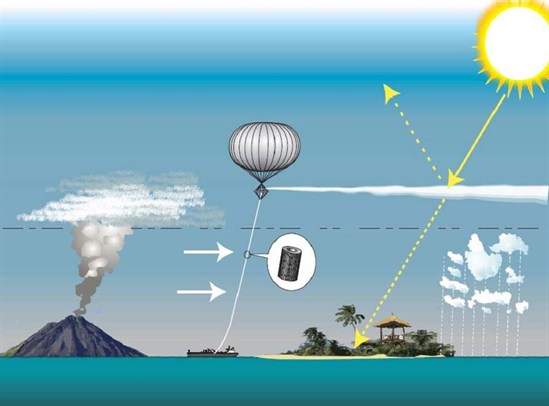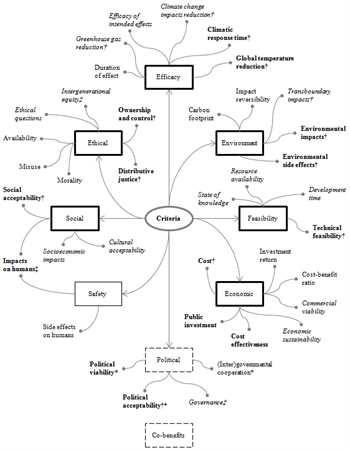Carbon Brief Staff
30.09.2014 | 3:15pmNext month’s synthesis report from the Intergovernmental Panel on Climate Change (IPCC) is due to give the organisation’s verdict on geoengineering, a radical set of proposals to use large-scale technologies to tackle climate change.
There are two types of geoengineering. Carbon geoengineering seeks to remove carbon dioxide from the atmosphere, for example by capturing it from the air and storing it underground, or by adding iron to the oceans to trigger carbon-absorbing algal blooms.
Solar geoengineering is different. It seeks to reflect some sunlight away from the Earth before it can be trapped by greenhouse gases. This can be done, for example, by spraying clouds with sea salt to make them more reflective, or by stratospheric aerosol injection, where reflective particles are pumped into the atmosphere.

My colleagues and I have been examining the importance of ‘opening up’ discussion about geoengineering to alternative options, different perspectives and real world complexity.
‘Closing down’ assessment
Our earlier research has shown that the ways in which researchers frame assessments of geoengineering have important effects on the conclusions people come to.
It’s common for such assessments to keep framings narrow. For example, researchers might choose to evaluate one or more geoengineering techniques, but not consider alternative options for tackling climate change, like renewable power or greener lifestyles.
Such narrow framings typically involve also leaving out public and stakeholder participation, obscuring social issues under technical criteria, and mishandling uncertainties by oversimplifying complexity.
Analysis of the frequency of different geoengineering proposals featured in standard appraisals shows a “closing down” particular proposals. Source: Bellamy et al., (2012)
Take the example of the UK Royal Society’s influential 2009 report into geoengineering. It convened a small group of experts to assess geoengineering proposals against four technical criteria: effectiveness, affordability, timeliness and safety.
It’s perhaps not surprising then that stratospheric aerosol injection, an apparently cheap, effective and fast acting proposal, came out of the assessment as the best choice. The assessment gave only a token nod to the uncertainties by adding arbitrary error bars.
We’ve found that this is a common theme. Through narrow framings, assessments of geoengineering have served to ‘close down’ on certain proposals, with stratospheric aerosol injection often coming out ahead.

Stratospheric aerosol injection means releasing small particles into the stratosphere which will reflect incoming solar radiation, cooling the Earth.
Another way?
This ‘closing down’ in assessments of geoengineering is a problem, because it risks locking us in to decisions that are not adequately informed and that will engender conflict between different values and interests.
Geoengineering is an issue that is too complex and has too much at stake to be decided by narrow framings that ignore broader concerns. That’s why we’ve suggested a new way to perform such assessments, that can help open up discussion about geoengineering.
Developing a technique called Deliberative Mapping (DM), we have assessed geoengineering proposals alongside alternative ways of tackling climate change, like low carbon lifestyles and renewable energy technologies.
We convened a small but diverse international groups of academic experts, civil society, government and industry stakeholders, alongside members of the public from Norfolk in the UK. We asked them to come up with a set of criteria that they felt were important when assessing different options to deal with climate change.
The criteria they came up with went beyond narrow technical criteria to include social issues such as politics, society and ethics. But they also came up with more in-depth technical criteria on effectiveness, environmental impacts, feasibility and economics.

Criteria for assessing geoengineering proposals identified by academic experts, civil society, government, industry stakeholders and the public. Source: Bellamy et al., ( 2014)
Where in other research, ‘effectiveness’ has often been simply equated to global temperature reduction, and ‘affordability’ to capital investment, our assessment broadened out those criteria to account for carbon dioxide reduction and litigation costs, amongst many other issues.
By expanding the criteria used to judge geoengineering and by measuring both the optimistic and pessimistic performance of each option, this method enabled our participants to consider all of the uncertainties in a much more substantive way.
A remarkable consistency
You might think that adding more options, perspectives, criteria and uncertainty into the mix in this way would make for more disagreement.
But the results of our assessment, published in Public Understanding of Science and in Global Environmental Change, actually reveal a remarkable degree of consistency.
It became clear that geoengineering proposals were outperformed by alternative options for tackling climate change for all of our expert, stakeholder and public groups.
This is a radically different finding to other assessments that have found geoengineering proposals, in particular stratospheric aerosol injection, to be preferable. In our study, aerosol injection actually performed so poorly that it ranked alongside doing nothing to tackle climate change at all.
This suggests that thinking carefully about how we make decisions about geoengineering is at least as important as the decisions we eventually make. I believe that continuing to ‘open up’ geoengineering assessment will allow us to find the most robust and responsible ways of tackling climate change in the future.
Dr Rob Bellamy is a James Martin Research Fellow in the Institute for Science, Innovation and Society at the University of Oxford. Follow him on Twitter @DrRobBellamy


